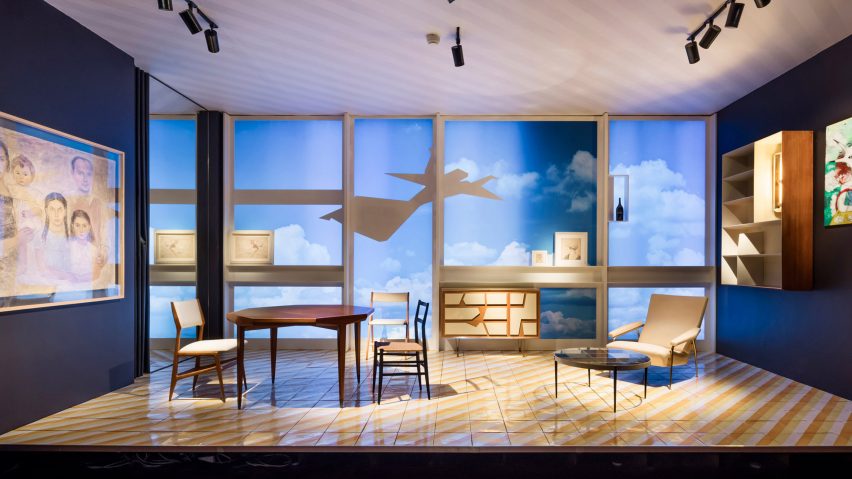An exhibition celebrating the career of Gio Ponti is on show at the Musée des Arts Décoratifs in Paris, featuring reconstructions of some the architect's best-known interiors.
As the first retrospective of the Italian architect and designer staged in France, Tutto Ponti: Gio Ponti Archi-Designer brings together more than 500 pieces from the archive of his work.
It covers Ponti's six-decade career, from 1921 to 1978, and includes architectural and industrial designs, furniture and lighting, magazines, as well as his forays into glassware, ceramics and metalwork.
It begins with an evocation of the 1970 Taranto Cathedral's openwork front inspired by paper cut-outs, before unfolding in chronological order into displays of his objects, furniture and architecture.
The triple-height space of the main hall is divided into five sections featuring Ponti's commissions, furniture, lighting and textiles, and architectural projects. These are detailed through drawings and papier-mâché models, as well as photographs and film.
The exhibition design, by Wilmotte & Associés with signage by Italo Lupi, makes full use of the space. It includes tall white room dividers intersected with large-scale reproductions of Ponti's work and photographs of the man himself.
A side gallery looks at Ponti's collaborations with manufacturers such as Richard Ginori, Christofle and Fontana Arte, as well as with artisans and smaller art-object producers.
Six period rooms in an adjacent gallery complete the exhibition with full reconstructions that demonstrate the reach of Ponti's work globally. Each reconstructed room represents a different period of his work.
These include the L'Ange Volant built outside Paris in 1926, the Montecatini building in Milan from a decade later, and the Great Hall at the Palazzo Bo, part of Padua University.
Completing the reconstructions are Gio Ponti's own home on Via Dezza in Milan, Villa Planchart in the Venezualan capital of Caracas, and the white and blue interior of the Parco dei Principi hotel in Sorrento in the 1960s.
The exhibition is curated by Olivier Gabet, Dominique Forest and Sophie Bouilhet-Dumas along with Gio Ponti's nephew, Salvatore Licitra.
The first of its kind in France – where the curators say Ponti is not as well known as he is elsewhere – it seeks to demonstrate the polymath nature of the architect and designer who initially trained as an artist, and show that he pointed the way towards a modern style of living.
"An eclectic architect and creator, interested in both industrial production and craftsmanship, Ponti enriched post-war architecture, indicating the prospects for a new art of living," explained the curators.
As well as producing architecture, furniture, ceramics, lamps and glassware, Ponti experimented with various materials including copper, enamel and silver leaf during his long career.
He was also the founder and, for two stretches, the editor, of Domus magazine, enlisting many friends and colleagues to write for the title.
Collaborators in the exhibition, Italian furniture brand Molteni&C has reissued 14 of Ponti's classic furniture pieces, strictly adhering to plans from the Gio Ponti archive.
These include perhaps his most recognisable design: the Superleggera or "super light" chair, a simple wooden frame with a woven rattan seat that weighs just 1.7 kilograms.
Molteni&C, who provided several pieces for the exhibition, won a court battle against fellow Italian furniture manufacturer Cassina in 2017, after the brand unlawfully produced for sale a copy of the D1563 chair to which Molteni&C holds the sole reproduction license.
Tutto Ponti: Gio Ponti Archi-Designer opened in October 2018, but its run has been extended until 5 May 2019 in response to visitor demand.
Photos are by Luc Boegly.

